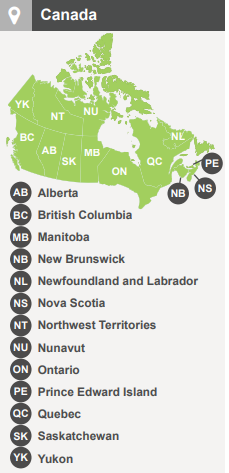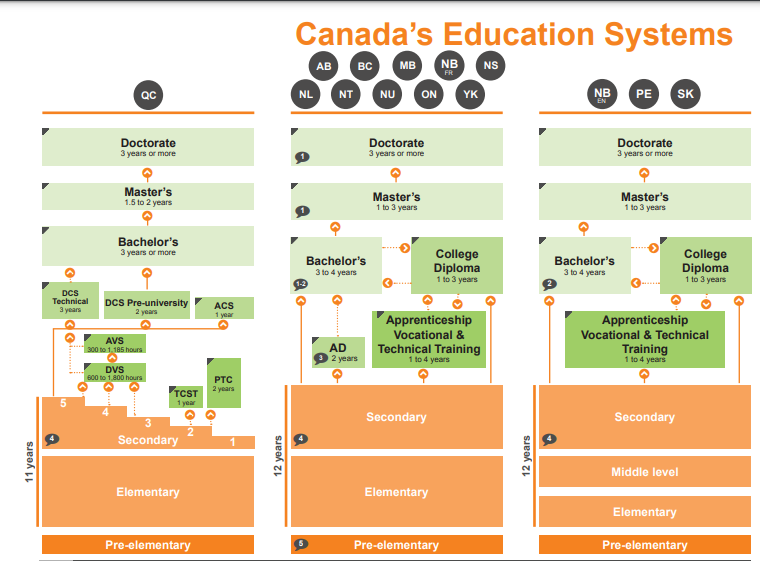Update: This article was last updated on 6th August 2024 to reflect the accuracy and up-to-date information on the page.

Each country has a different education system, and Canada has earned a name for itself on the global stage for having an excellent education system. If you’re moving to Canada and keen to understand the intricacies of its education system, let us be your guide. This blog will help you discover Canada’s rich tapestry of educational opportunities.
Recommended Reading: TOP PRIVATE SCHOOLS IN CANADA
Before we get started, have a look at this video.
So, first thing first.
Unlike the United States, where the U.S. Department of Education is an agency of the federal government responsible for establishing policies and administering federal assistance to education, Canada has a provincially regulated educational system. Each province in Canada is responsible for its educational policies and administration.
Provinces in Canada and their education system

<–Source: Council of Ministers of Education, Canada
The country comprises ten provinces and three territories: Yukon, Northwest Territories, and Nunavut. While the provinces hold constitutional status, the territories are subject to closer oversight by the federal government in many aspects.
So, each of Canada’s 13 provinces and territories operates its school system, ensuring adherence to government standards and delivering high-quality public education nationwide.
School attendance is mandatory for children aged approximately 6 to 18 years old, who have the option to attend either public or private schools.
Public schools are funded by the government and are operated by school boards or the province/territory.
Private/independent schools, on the other hand, are managed and administered by private individuals or organizations such as churches, trade unions, businesses, or foreign/international agencies.
According to Statistics Canada, despite the challenges posed by the COVID-19 pandemic, over 380,000 students successfully graduated from Canadian high schools.
Higher Studies: After secondary school, students can pursue a college or university education. Both options provide valuable opportunities for future career preparation.
The college offers practical, hands-on skills training in specific careers like graphic design, web development, culinary arts, and occupational health. These programs typically last one to three years, resulting in a certificate or diploma upon graduation. Colleges often collaborate with industry employers to ensure curricula align with the latest trends.
On the other hand, universities focus on in-depth theoretical subjects such as law, medicine, art history, engineering, and more. University programs usually span three to seven years, leading to Bachelor’s, Master’s, or Ph.D. degrees upon completion.
Exception: Quebec Province

In Quebec, students have a unique option called CÉGEP after secondary school. They can attend CÉGEP and choose between a three-year technical program for job-specific skills or a two-year academic program to prepare for university studies.
Summary
Canada is an excellent destination for international students, offering outstanding educational opportunities. The decision between college and university depends on the interests and goals of individual students.
⦁ Canadian institutions offer flexibility, allowing for transferring academic credits between schools if you switch institutions during your studies.
⦁ Many Canadian universities are well-regarded and feature prominently in renowned university rankings, such as the University of Toronto Ontario, the University of British Columbia, McGill University, McMaster University, the University of Montreal, the University of Alberta, and the University of Ottawa.
⦁ Some programs at colleges and universities offer cooperative or work-integrated learning experiences.
⦁ Cooperative or work-integrated learning allows students to alternate between classroom studies and practical work in their chosen field.
⦁ Individuals can attend college and university, tailoring their education to their needs.
The educational infrastructure

Source: Council of Ministers of Education, Canada
Schooling
Pre-Elementary
Kindergarten programs are available across all provinces and territories in Canada, offering both full-day and half-day options. The attendance requirement for kindergarten varies by region, with some programs being mandatory while others are voluntary. Kindergarten is essential to Canada’s formal education system, with dedicated curricula in all 13 provinces and territories.
Elementary Public School
– The country has 10,100 elementary schools.
– Compulsory schooling ages differ across provinces and territories, with most requiring attendance from ages 6 to 16.
– Some regions start at age 5, while others continue until age 18 or completion of secondary school.
– Elementary schools typically span six to eight years; nearly 98% of elementary students progress to the secondary level.
Curriculum in Elementary Education
– The curriculum encompasses basic subjects of language, mathematics, social studies, science, health and physical education, and introductory arts.
– Some provinces and territories include second-language learning.
Secondary School
2,600 secondary schools that cover the final four to six years of compulsory education.
Curriculum in Secondary Education
– In the first year, the curriculum primarily comprises compulsory courses with a few optional choices. As students progress to later years, they can take specialized courses to prepare for the job market or meet specific entrance requirements of postsecondary institutions.
– Secondary school diplomas are granted to students upon the successful completion of mandatory and optional courses.
– In most secondary schools, students can enroll in vocational and academic programs. However, there are also dedicated vocational training centers that offer specialized technical and vocational programs.
– Students interested in pursuing specific trades can choose from various program durations, ranging from less than a year to three years, which often result in the attainment of diplomas and certificates.
Mixed elementary and secondary schools: 2,100
Higher Studies
– Canada boasts many educational opportunities, with 223 public and private universities and 213 public colleges and institutes.
– The country offers over 10,000 undergraduate and graduate degree programs encompassing various fields of study.
– Additionally, Canadian universities provide professional degree programs and certificates, further expanding the educational options available to students.
– Most institutions provide instruction in English or French; others offer education in both official languages. In 2020, Canadian universities employed over 47,000 full-time faculty members.
Vocational education
Vocational education encompasses multi-year programs or courses that provide specialized instruction in specific skills or trades, aiming to prepare students for direct entry into related careers or further education in those fields.
These programs are available at both secondary schools and postsecondary institutions, including public colleges, private for-profit colleges, and through workplace apprenticeship programs.
At the secondary level, vocational programs may be offered either at dedicated specialized schools or as optional programs within schools providing both academic and vocational streams.
These programs equip students for employment, postsecondary studies, or apprenticeships.
Indigenous Education
The Canadian Constitution recognizes three groups of Aboriginal peoples: First Nations, Inuit, and Métis. The federal government shares responsibility with First Nations for educating on-reserve children attending provincial, national, or band-operated schools.
Indigenous children living off reserve, including Métis and Inuit, are educated in public schools within their communities, with provinces and territories primarily responsible for educational services.
Indigenous students pursuing postsecondary education can choose government-supported or private institutions offering various programs.
Specialized and culturally relevant programming is available in Indigenous postsecondary institutions and Indigenous-led faculties within non-Indigenous establishments across Canada.
Apart from that, Canada also offers adult education and skills training, professional certifications, language schools, and online and distance learning.
This article aims to provide newcomers to the country with an overview of the Canadian education system and guide them in navigating it. That said, conducting further research based on your location and personal preferences is essential. For detailed information, refer to the Council of Ministers of Education, Canada, an intergovernmental organization established in 1967 by education ministers. Their resources can offer valuable insights and specific details about your educational needs in Canada.
Moonpreneur is dedicated to transforming conventional education, preparing the next generation with comprehensive learning experiences. Our Innovator Program equips students with vital skills in AI/ML, Robotics, Coding, Game Development, and App Development, fostering entrepreneurship through hands-on learning. This initiative aims to cultivate the workforce of tomorrow by integrating innovative technologies and practical skills in school curriculums.
Register for a 60-minute free workshop today!

























Is it possible for a foreign child to enroll in a public school in Canada?
Numerous Canadian public high schools currently welcome international students into their programs. Publicly funded schools are overseen locally by elected school boards, offering a standardized curriculum or program of study.